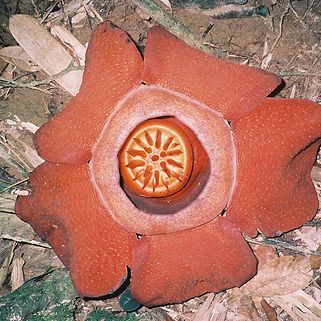Herbs, fleshy, parasitic on roots, stems, or branches of various hosts. Vegetative body thalloid or reduced to myceliumlike tissue within host. Normal leaves absent. Inflorescences terminal, usually 1-flowered, rarely a spike; bracts scale-like, several at base of inflorescence. Flowers usually unisexual (plants dioecious or monoecious), bisexual in Mitrastemon, actinomorphic, minute to extremely large [Rafflesia arnoldii R. Brown of Indonesia (Sumatra) produces a flower to 7.5 kg and to 1 m in diam.], 4-10-merous. Perianth lobes well-developed or absent, basally connate, rarely free. Stamens 5 to very numerous, in 1-3 series, fused with the rudimentary pistil into a gynostemium or in bisexual flowers connate into a cylinder; free filaments absent; anthers 2-loculed, dehiscent longitudinally or by apical pores. Ovary superior, semisuperior, or inferior, absent in male flowers, 1-loculed with many parietal placentas; ovules numerous, anatropous, integuments 1 or 2. Style 1 or none; stigma discoid, capitate, or with many lobes. Fruit a berry. Seeds minute, very numerous; testa hard; endosperm present.
Parasitic plants on roots and branches of various hosts, thalloid, or vegetatively reduced to an almost mycelial endophytic system with only the flowers emerging from the host tissue, achlorophyllous, monoecious, dioecious, or rarely the flowers of one plant bisexual
Stamens 8–many usually fused, in 1–3 series around a fleshy central column; disk sometimes present; anthers sessile, dehiscing by slits or terminal pores
Perianth ± epigynous, sometimes fleshy; perianth segments (tepals)3–12, free or basally connate, imbricate or valvate, 1–2-seriate
Ovary ± inferior, unilocular; ovules numerous, pendulous from apex of loculus or with parietal placentation
Flowers very small to very large, solitary (rarely in spikes), subtended by bracts, actinomorphic
Leaves absent (or reduced to scales subtending the flowers)
Stigma discoid, capitate or many-lobed
Seeds minute, numerous, albuminous
Style 1 or absent
Fruit a berry

